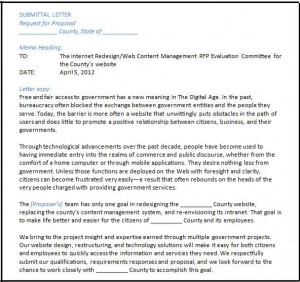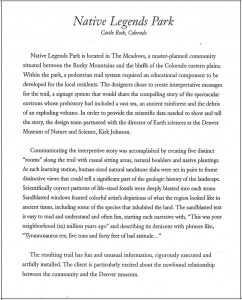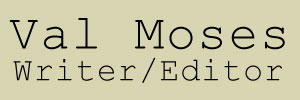 No one wants to make a reviewing committee’s eyes glaze over with boilerplate copy. But there’s also the danger of heaping so much material into a proposal that they won’t ever get to the good stuff.
No one wants to make a reviewing committee’s eyes glaze over with boilerplate copy. But there’s also the danger of heaping so much material into a proposal that they won’t ever get to the good stuff.
I help firms by creating highly targeted, carefully honed writing that takes a fresh approach to the task of putting together proposals. A response to a Request for Proposal (RFP) can take advantage of everyday elements by finding new purpose and form in them. Here are some examples:
Make your pitch with your cover letter
 Proposing teams often overlook the opportunities in a submittal letter.
Proposing teams often overlook the opportunities in a submittal letter.
This is your first touch with the reviewing committee and it can say a lot more than just, “We are pleased to present our proposal…”
The cover letter at left was in response to an RFP that sought a team to completely redesign a county government website in order to make it much easier for constituents to find and use services online.
(Click the image to read the letter.)
Distinguish your firm in a meaningful way
 Many firms believe the words “unique” and “innovative” will make them just that. Guess what? There are too many people saying that about themselves.
Many firms believe the words “unique” and “innovative” will make them just that. Guess what? There are too many people saying that about themselves.
Remember that someone has to read this, and they probably have to read many more from other firms. Bring the words to life. Give reviewers something informative but at the same time unexpected. Think about using this part of a proposal to answer the question, “Why choose us?” I worked with one company to do just that on their website by dividing it into several answers, with a paragraph for each, making it accessible and easy to digest. People could read as much or as little as they wanted, but each answer led to the next. This page could then be adapted to create a firm profile for proposals that wasn’t just boilerplate.
Sell your past experience as the future of their project
 It’s natural to want to impress a potential client, but the real task is to match your experience with what they need–to give them a reason to keep reading your proposal.
It’s natural to want to impress a potential client, but the real task is to match your experience with what they need–to give them a reason to keep reading your proposal.
Descriptions of work similar to the RFP should be short and to the point. They must be well-chosen and targeted to the needs of the project–with language that is concrete. Instead of using the ubiquitous “award-winning,” can you identify an award you’ve won that is relevant to the client’s project? Have you written white papers, given speeches or taught classes on topics related to this type of project? Do you have a testimonial you can share? You may have more resources, and more compelling resources, than you think.
Click the page above to read a project description for a proposal on a narrative landscape for a natural history museum.

